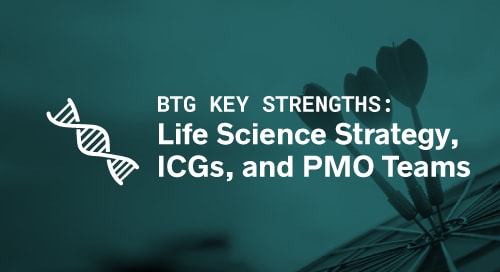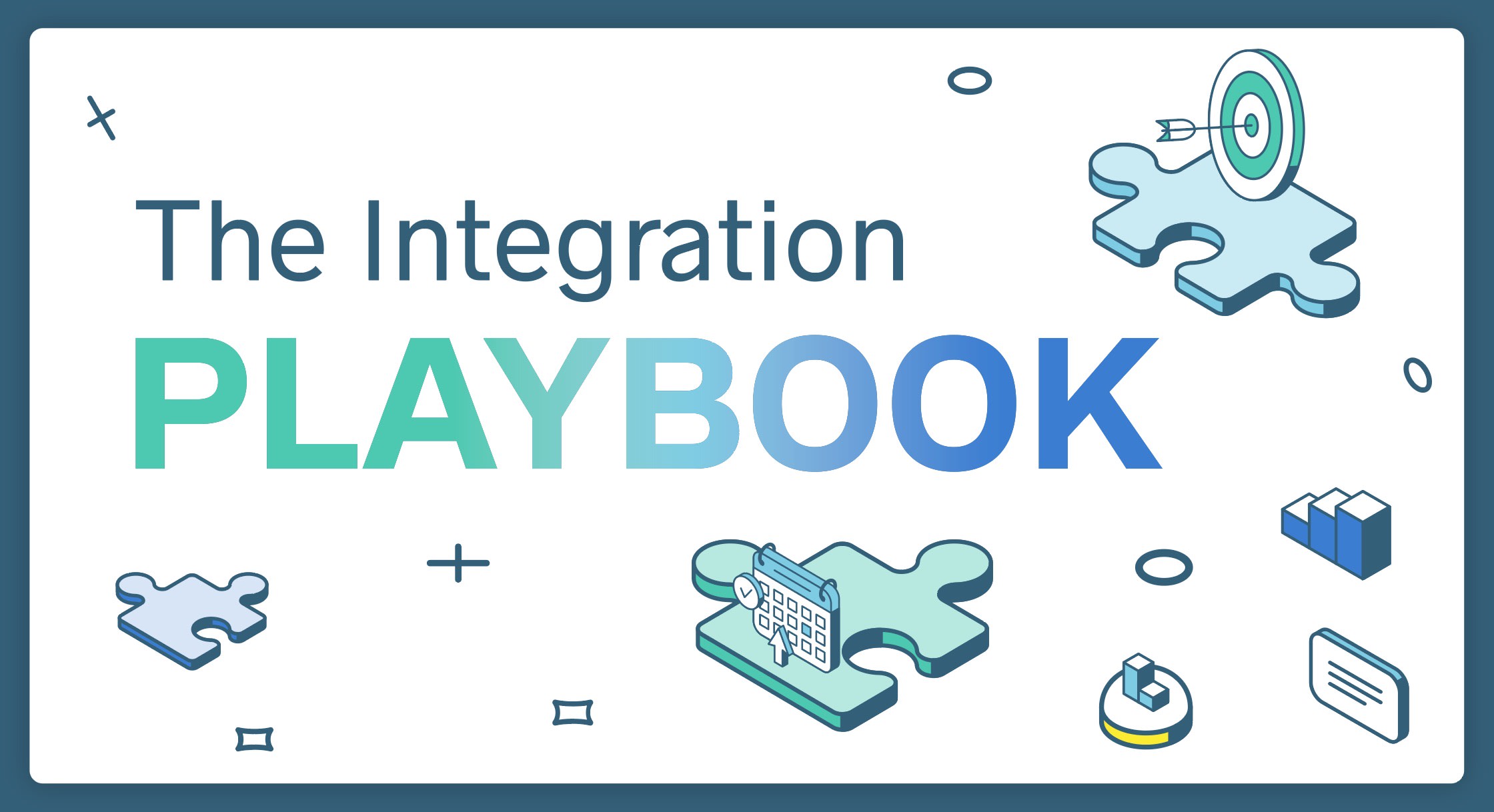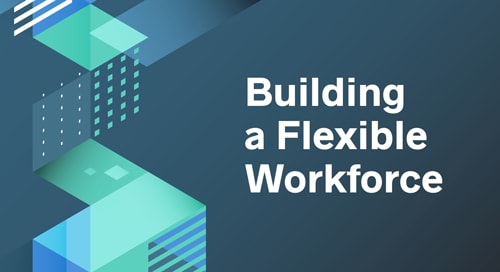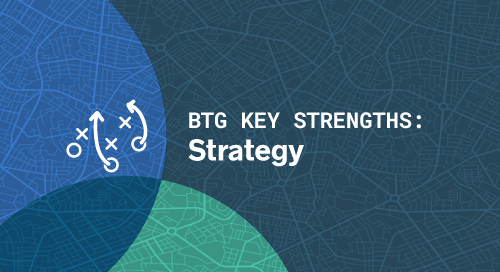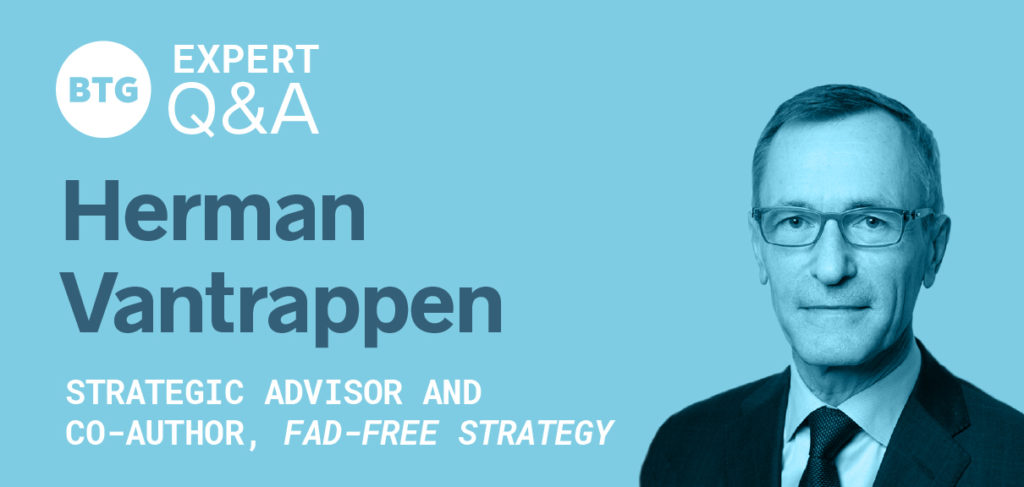
Herman Vantrappen is the Managing Director of Akordeon, a strategic advisory firm that serves large and medium-sized clients in a range of industries around the world. Together with Dr. Daniel Deneffe, another strategic advisor and consultant who teaches at Hult and Harvard, he released a book called Fad-Free Strategy.
We recently spoke to Mr. Vantrappen about why he wrote the book—and how his approach to business strategy can help executives make more confident, efficient, and evidence-based decisions.
You wrote Fad-Free Strategy to help managers break free from the simplistic promise that following market leaders like Amazon and Google can help them “win” their own markets. Let’s talk about your approach, starting with the distinction you draw between Grand Strategy and Operational Strategy.
That is right: We introduced the notions of Grand Strategy and Operational Strategy. In fact, Grand Strategy and Operational Strategy are two high-contrast archetypes that we are introducing primarily for didactic purposes. Richard Thaler and Cass Sunstein have done something similar in their famous book Nudge, in which they make the distinction between Econs and Humans. Or take the distinction that Daniel Kahneman makes between System 1 and System 2 in his book Thinking, Fast and Slow.
Can you tell us a bit more about Grand Strategy?
Most people will immediately recognize Grand Strategy as something they already do in their company today. It is about defining the company’s overarching vision, it is about setting ambitious goals (for instance about the revenues or the market position to be achieved, say, 5 years down the road), and it is about making high-level choices about where and how to compete: in which existing or new markets, with which products, with which partners, etc. Most companies at some point in time go through such an exercise, calling the outcome, say, “Vision 2025”. And they then regularly update those visions as they progress.
And is there anything wrong with that?
There is nothing wrong with Grand Strategy, quite to the contrary. For instance, a Grand Strategy helps to define the boundaries of what the company will NOT do. And a Grand Strategy helps to rally people around a shared goal. The problem occurs when the company’s top management team, after having defined such a “Vision 2025,” then tells their operational managers: “From now on, it is up to you guys to execute the strategy.” What we are advocating is that managers should not execute those Grand Strategy choices straight away. They should still look at those Grand Strategy choices as hypotheses that still need to be tested through what we call Operational Strategy.
So what about Operational Strategy?
Operational Strategy is about testing the hypotheses that have come out of Grand Strategy. It would take us too far to explain in detail how such testing should be done, but in essence it must be based upon a thorough understanding of customers’ preferences and behavior. Such testing can lead to two outcomes. Either, the Grand Strategy hypothesis is confirmed, possibly with a bit of fine-tuning of the strategic choices. Or, what is also possible, the Grand Strategy hypothesis is rejected altogether. That may be an unfortunate outcome, but at least it prevents sinking millions of additional development and marketing costs in a strategy that in most likelihood was going to fail.
Could you give us a concrete example?
Sure. Imagine we are a US-based fast-food chain, with a strong nationwide position in the U.S. The U.S. market is maturing, though, and the scope for further growth in the U.S. is fairly limited. So, we are wondering: why don’t we enter the European market? After all, McDonalds, Burger King, and others have done so successfully, why couldn’t we do it as well? Hence, let’s do a Grand Strategy exercise: we look at demographic data in each European country, we look at changing dining habits of European consumers, we look at COVID-triggered trends linked to WFH, urban planning and takeaway delivery services, we look at the product range of existing fast-food chains, we do some back of the envelope calculations about ramp-up speed and investments, and we come to conclusion: yeah, entry in Europe seems to be a promising strategic choice. So, we prepare a nice presentation for the Board of Directors, with a 10-year projection of cash flows, and we request their approval. That is Grand Strategy. Very familiar.
But that Grand Strategy can only be a hypothesis. It still needs to be tested before pushing the “execute now” button. We could, for instance, zoom in one specific European country, say, France. We should then gather real evidence from the field, that is, from customers, to test our hypothesis that entering France is a good strategic choice indeed. In essence such testing should answer three questions.
- The first and most difficult question is: how many consumers in France will actually switch to our product, at the price we have in mind, given what they are willing to pay, and given their best current alternative, which may be: going to, for instance, McDonald’s, or simply dining at home?
- The second and slightly easier question is: how will competitors react to our entry and our offering? Will they emulate our product? Will they respond by a price cut? Etc.
- The third, and usually easiest question is: How much do we need to invest and spend?
Those don’t sound like easy questions to answer.
Well, when we explain the first question to managers, about how customers will behave, we often get two kinds of reactions:
- The first reaction is: But finding out about customers, isn’t that ordinary market research? Aren’t their many well-established methods to find that out, ranging from net promotor score to conjoint analysis?
- The second, in a way opposite reaction is: Wow, that is really most impressive, understanding customer behavior to that depth! But is it really possible? Isn’t it too good to be true?
The answer to both questions is: there is a superior and effective method to really understand customers’ preferences accurately. Again, it would lead us too far here to explain in detail, but conjoint analysis, for example, has serious shortcomings.
What is the origin of the method you are proposing?
In essence, the foundations of the method that we are proposing are not new. The method is based on decision science and microeconomic utility theory, which have been around for over half a century. The method extracts preferences and ultimately willingness-to-buy at different prices for any offering that a company can bring. I use the word “extract” because people do not necessarily know their preferences. They find it hard to express them, and definitely so for new products having a variety of features and benefits that they never encountered before. Think, for example, of the GPS device when it was first introduced two decades ago.
To uncover and craft those preferences, we use a preference elicitation method. In essence we conduct in-depth interviews with a sample of potential customers to identify their point of indifference between pairwise options, that is, between two offerings having different combinations of features or, more generally, benefits. It is the point at which the customer can no longer choose between the two offerings presented at that moment. Using these indifference values, and making the very reasonable assumption that customers go for the best deal, we craft an individual customer’s entire preference structure. That allows us to accurately forecast choices that an individual customer would make between any of the company’s possible offerings and between these and the customer’s best alternative. Note that, in order to minimize bias, the method does not rely on any direct price questions.
So, coming back to the original question, Grand Strategy and Operational Strategy are complementary?
Absolutely. Grand Strategy, Operational Strategy and Strategy Execution form an end-to-end process. We are advocating that companies, before executing important strategic choices, before pushing the “commit” button, that they get much better evidence about customer behavior. Because ultimately, whether a strategy will generate the aspired financial results does not depend on the ambitions let alone the dreams of the company’s executives but on the choices that customers make.
Most business strategy books would start the Operational Strategy phase by segmenting a market and mapping different offerings to each. But Fad-Free Strategy recommends starting with individual customers and aggregating from there. Can you explain?
Sure. If you think about it, most strategists and marketeers love bubble charts. You know those two-dimensional diagrams, in which each bubble represents a business or a market. Strategists use the bubble chart to show, on the one hand, the attractiveness of the market in which a given business of the company is active, and, on the other hand, to show the strength of the company in that business. The position of the business in the bubble chart could inform the strategic decision you may make: let’s invest in the business, let’s exit the business, etc. Likewise, marketeers use the bubble chart to show, for instance, the average spend per user in a given segment, and the number of customers in that segment.
Such bubble charts can very helpful when doing Grand Strategy, to get a feel for business opportunities, to generate creative new product ideas, what have you. Unfortunately, such bubble charts suffer from one big shortcoming: by definition each bubble represents an average. But in strategy, averages never matter. Strategy is not about doing the same thing, but about doing things differently. There are no general strategies (for example, “low cost” versus “differentiation”) that always work, just as there are no general strategies that always work in chess-games. In fact, when playing against a star chess player, one may have just one chance out of 1000 to win the game. When doing the same as the champion, chances are zero.
Could you elaborate on why segments aren’t all that useful?
When people define market segments, they lump individual customers together into a group that is supposed to be reasonably homogenous. For example, in B2C markets a segment may be defined in terms of age, gender, income, hometown, professional occupation, etc. In B2B markets a segment may be defined in terms of application, geography, size, profitability, etc. The reality is, however, that no two potential customers can be claimed to be identical, at least not upfront. Two different customers have different preferences. You and I may have the same professional occupation, the same income, the same household composition, etc., and hence be part of the same “segment”, but may nonetheless make totally different choices when it comes to selecting, say, a fast-food restaurant. In our experience, belonging to a defined segment is often not a good predictor of customer preferences or of the choices that a given customer will actually make.
In other words, we advocate to be customer segment agnostic. Don’t assume anything. Don’t reason top-down; reason bottom-up, with the individual customer being at the bottom.
How do you apply that kind of bottom-up reasoning in practice?
Practically speaking, it means the following: we talk to a sample of individual customers, with a blank sheet of paper, and extract the specific preferences of each individual customer. That means four things:
- To begin with, we check whether this customer is part of our potential market. For instance, when talking about fast-food, she may say: “I only consider vegan-only restaurants; I don’t even think of going to any other type of restaurant.” If we are not vegan-only, there is no point in pursuing this customer.
- Assuming she is a potential customer, we estimate her willingness-to-pay for improvements in the features (or, more generally, “benefits”) of our offering above her minimum requirements. But to minimize bias, we don’t ask any direct price questions. Instead, we assess the trade-offs she makes between pairs of features. For instance, assume that “speed of drive-thru service” and “menu variety” are two features of our offering. We would want to find out what improvement in the speed of drive-thru service she would need relative to her minimally acceptable level (say, no more than 10 minutes) in exchange for a specified improvement in menu variety. We do that questioning for the full range of feasible improvements in speed of service. Later on, we do the same for all the relevant features that we could technically improve, that is, not just drive-thru speed but also parking lot size, accuracy of the order, friendliness and the like. By doing so, we arrive at a full picture of the “value” (or economists call it “utility”) that this specific customer attaches to the features of our offering, including its price.
- In the third step, we estimate by how much the same customer prefers her best current alternative over ours. Again, we don’t make direct comparisons with competitors but extract that information indirectly.
- Finally, in the fourth step, we have the same interviews with all other individual customers in the chosen sample and aggregate the results.
It would lead us too far now to explain the techniques used in those four steps in detail, but it is fairly simple. It does not involve any statistical processing. The only skill needed is one that we all have: summing up.
So, it’s all about modelling customer behavior?
That’s right. The important thing really is that we get to an accurate picture of how we can expect customers to behave in reality, and hence how much volume we can expect to sell at what price.
Of course, after having measured those preferences through this bottom-up process, segments possibly could be identified. This is the case when two conditions are met. First, when groups of customers can be identified with relatively similar needs and willingness-to-buy, and, second, when the similarity of preferences can be linked to observable characteristics. In our experience these evidence-based real segments, if existing at all, often differ significantly from the a priori segmentation made internally.
In Fad-Free Strategy, you advocate a very rigorous methodology for understanding customers’ behavior, switching costs, and unmet needs. What’s the evidence that it works?
The core of the method originates from scientific work done by Professor Wakker and Deneffe (my co-author), as documented also in their seminal article published in Management Science in 1996. We have subsequently adapted that work to business settings, and applied and finetuned it in numerous real-world situations for some 20 years. We have done so in a very wide range of markets, both B2B and B2C. We find that the method is equally applicable to commodities (think cement), innovative products (e.g. advanced battery materials), services (e.g. payroll processing), platforms (e.g. speed camera information exchange platforms) or any other product, service or solution.
In fact, it should not be a surprise that the method is valid and widely applicable. After all, it is based on only a couple of basic behavioral assumptions with which one could hardly argue. If one agrees with those assumptions and follows the method, one has no choice but to agree also with the revenue forecasts that flow from it.
Tell us a bit more about these “basic behavioral assumptions.”
The most salient of those behavioral assumptions is that of “highest deal value.” It says the following: when faced with a number of alternatives, a customer will pick the alternative that gives him the best deal, that is, the alternative with the largest difference between his willingness-to-pay and the price he has to pay for it. Sounds more than reasonable, doesn’t it?
The real question is, how to increase deal value? To increase the deal value for a given customer sufficiently to make him switch, a company can make one of three moves:
- Decrease the price of that product, provided the product satisfies the customer’s minimum requirements, that is, his must-haves. If it does not, the customer won’t buy even at a price of zero.
- Add more benefits for which the customer is willing-to-pay, while keeping the price constant.
- A combination of the above, that is, remove benefits that decrease the willingness-to-pay by less than the price decrease, or add benefits that increase the willingness-to-pay by more than the price increase.
All of these critical switching points will differ across individuals since their preferences differ. Hence, by inferring the effect of all those potential moves on the respective switching behavior of a representative sample of individual customers, one can derive an estimate of the true demand curve for any product within the capabilities of the company. By multiplying volumes and prices, one also gets the revenues, as well as the margins, provided costs are known. This is the most important information a company can have: an evidence-based forecast of the revenues it can generate within its capabilities.
Fad-Free Strategy explores how the concepts we’ve discussed translate onto various real-world strategic scenarios, from entering new markets to improving profits in commoditizing ones. Now, being disrupted by a competitor is one of the great business fears of our age. So could we talk through some of your thoughts about developing successful defense strategies?
You are absolutely right about the fears provoked by an aggressive new entrant. I can think of three reasons why such an entry is profoundly unsettling. First, in most industries there is some kind of a modus vivendi among the incumbents. Without there being any form of collusion whatsoever, they realize that everyone risks losing if one of them starts behaving irrationally. But a new entrant upsets that precarious equilibrium and reduces the predictability of the business, all of which unsettles the incumbents. Second, in most cases, the new entrant, with his offering, does not increase the size of the pie, but takes a piece of it, away from the incumbents. And third, incumbents could respond by lowering prices, but given their size and many other reasons this is often not desirable.
In short, a new entrant is often cause for panic, so to speak, and when people panic, they do not always react rationally, let alone thoughtfully. When people panic, they tend to revert to some dogmatic beliefs or generic decision rules.
Can you give an example of such a dogmatic belief?
For example, some managers believe in a “zero-tolerance” attitude. Their reasoning is that there should be no doubt whatsoever among new entrants that any price cut they make will be matched immediately by an equivalent price cut. In other words, these managers adhere to an unconditional tit-for-tat approach. But other managers, even in the same company, may have the opposite belief. They are adamant that one should never respond with a price-cut to low-priced entrants, because, they reason, it is a never-ending game that destroys the market for all. Instead, they reason, one should respond by somehow differentiating one’s products.
Who of the two is right?
Well, there is no general right answer. The best defense strategy very much depends on the specific case. Let’s take an example. Let’s assume that the incumbent is the Coca-Cola Corporation and that it gets attacked by a low-priced unbranded product in one of its product categories. Assume, in addition, that Coca-Cola has 99% market share, that the new entrant entered at a somewhat lower price than Coca-Cola. Finally, assume that Coca-Cola’s superior brand name and Coca-Cola customers’ loyalty prevented the entrant from obtaining more than 1% market share. If the new entrant now decides to get aggressive and cuts prices further by 20%, its market share may increase from 1% to 2%. If Coca-Cola does not respond with a lower price, and if the entrant’s unit variable costs are not too high, such a price cut is a meaningful proposition for the entrant, since after all it doubles its volume. For Coca-Cola, however, responding with an equivalent 20% price cut to keep 99% instead of 98% market share is way too costly relative to accommodating the entrant and accepting a minor erosion of its market share. If Coca-Cola lowered its prices, it would have to do so for all its volumes, and as a consequence it would lose lots of profits, much more than the profit lost from losing 1% market share.
This is just one example. The message is that the defense strategy needs to be defined as a function of the specific situation. Key is to understand, again, customer preferences, the choices customers make to maximize their deal value, the position and the behavior of the various incumbents in the market, and the entrant’s objectives, incentives and behavior.
That all sounds like hard work…
If it sounds like hard work, it does because it is hard work. But who said credibly that strategy is easy? In the newspapers we all read about sensational companies making sensational headlines, like virtual reality meetings, vertical urban farms, you name it. But you know, 99% of companies are “just” what one could call “mainstream”, “middle-of-the-road” businesses whose managers labor every day to try and earn a reasonable, decent return on capital. Doing business is hard operational work, and so is strategy. But there are solid ways of thinking as well as practical methods to make that work more enjoyable and effective. And that is simply what we tried to write down and share in our book.
Find out more about Mr. Vantrappen’s approach to making better business strategy decisions or get the book on the Fad-Free Strategy website.
GET THE SKILLS YOU NEED
Thousands of independent consultants, subject matter experts, project managers, and interim executives are ready to help address your biggest business opportunities.





